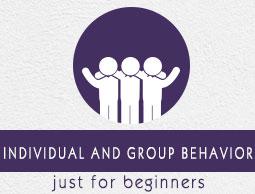Factors Influencing Individual Behavior
The way an individual addresses a situation single-handedly or say in a group is influenced by many factors. The key factors influencing an individual’s attitude in personal as well as social life are −
- Abilities
- Gender
- Race and culture
- Attribution
- Perception
- Attitude
Let’s take a quick look over these major elements that imprints a person’s behavior inside and outside of the organization.
Abilities
Abilities are the traits a person learns from the environment around as well as the traits a person is gifted with by birth. These traits are broadly classified as −
- Intellectual abilities
- Physical abilities
- Self-awareness abilities
In order to understand how these affect a person’s behavior, we need to know what these abilities are.
Intellectual abilities − It personifies a person’s intelligence, verbal and analytical reasoning abilities, memory as well as verbal comprehension.
Physical abilities − It personifies a person’s physical strength, stamina, body coordination as well as motor skills.
Self-awareness abilities − It symbolizes how a person feels about the task, while a manager’s perception of his abilities decides the kind of work that needs to be allotted to an individual.
Thus the psychological, physical, self-assurance traits owned by a person defines the behavior of a person in social and personal life. For ex: Ram has a high IQ level, whereas Rahul can lift a bike and is a strong guy.
Gender
Research proves that men and women both stand equal in terms of job performance and mental abilities; however, society still emphasizes differences between the two genders. Absenteeism is one area in an organization where differences are found as women are considered to be the primary caregiver for children. A factor that might influence work allocation and evaluation in an organization is the manager’s perception and personal values.
For example − An organization encourages both genders to work efficiently towards the company’s goal and no special promotion or demotion is given or tolerated for any specific gender.
Race & Culture
Race is a group of people sharing similar physical features. It is used to define types of persons according to perceived traits. For example − Indian, African. On the other hand, culture can be defined as the traits, ideas, customs and traditions one follows either as a person or in a group. For example − Celebrating a festival.
Race & culture have always exerted an important influence both at the workplace as well as in the society. The common mistakes such as attributing behavior and stereotyping according to individual’s race & culture basically influences an individual’s behavior.
In today’s diverse work culture, the management as well as staff should learn and accept different cultures, values, and common protocols to create more comfortable corporate culture.
For example − A company invites candidates for a job post and hires one on the basis of eligibility criteria and not on the basis of the country a person belongs to or the customs one follows.
Perception
Perception is an intellectual process of transforming sensory stimuli into meaningful information. It is the process of interpreting something that we see or hear in our mind and use it later to judge and give a verdict on a situation, person, group, etc.
It can be divided into six types namely −
Of sound − The ability to receive sound by identifying vibrations.
Of speech − The competence of interpreting and understanding the sounds of language heard.
Touch − Identifying objects through patterns of its surface by touching it.
Taste − The ability to detect flavor of substances by tasting it through sensory organs known as taste buds.
Other senses − Other senses include balance, acceleration, pain, time, sensation felt in throat and lungs etc.
Of the social world − It permits people to understand other individuals and groups of their social world.
For example − Priya goes to a restaurant and likes their customer service, so she will perceive that it is a good place to hang out and will recommend it to her friends, who may or may not like it. However, Priya’s perception about the restaurant remains good.
Attribution
Attribution is the course of observing behavior followed by determining its cause based on individual’s personality or situation.
Attribution framework uses the following three criteria −
Consensus − The extent to which people in the same situation might react similarly.
Distinctiveness − The extent to which a person’s behavior can be associated to situations or personality.
Consistency − The frequency measurement of the observed behavior, that is, how often does this behavior occur.
The framework mentioned says it is all about how an individual behaves in different situations.
For example − Rohit invites Anisha and two more friends for a movie and they agree to bunk and watch the movie, this is consensus. Bunking of class says that they are not interested in their lectures, this is distinctiveness. A little change in the situation, like if Rohit frequently starts bunking the class then his friends may or may not support him. The frequency of their support and their rejection decides consistency.
Attitude
Attitude is the abstract learnt reaction or say response of a person’s entire cognitive process over a time span.
For example − A person who has worked with different companies might develop an attitude of indifference towards organizational citizenship.
Now we have a clear idea about what are the factors responsible for the way we behave. We never think about these elements and how they affect our daily life but we can’t ignore the fact that they are responsible for the way we walk, talk, eat, socialize, etc.


